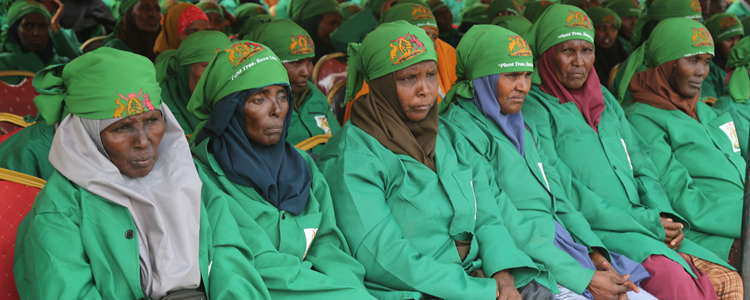Water, Energy, Environment & Clmate Change
Departments
The department of water services has five sections headed by assistant directors namely: water resources, planning and design, water & Sewerage Development, operations and maintenance, and water serves provision management.
Achievements
The achievements of Water Services Department since the advent of devolution in 2013 have been summarized by the table below:
From the inception of the new dispensation in 2013, the County has made tremendous strides in the provision of water accessibility. We inherited only 69 existing boreholes, and today the county has 224 functioning boreholes translating to an additional 147 boreholes.
In 2013, the county had no existing earth pan/ dam (60,000M3 and above). Today the county has 40 dams.
Small medium pans / dams (>/=10,000M3) had increased from 86 in 2013 to 258 by mid 2023 translating to an additional 172 dams.
Infiltration Galleries & Protected Wells had increased from 15 in 2013 to 24 by 2023 translating to an additional 9 Infiltration Galleries & Protected Wells.
UGTs/ “Berkads” had increased from 90 in 2013 to 287 by mid of 202 translating to an additional 197 UGTs/ “Berkads”.
Therefore, the total number of water sources increased from 260 n 2013 to 755 by July 2023 translating to an additional 495 water sources
The county had only one Urban W/Supplies in 2013. By the mid of 2023, the county has established an additional 5 urban water supplies.
Rural W/Supplies had increased from 67 in 2013 to 168 by July 2023 translating to an additional 101 Rural W/Supplies.
The Institutional W/Supplies had increased from 2 in 2013 to 7 by July, 2023 translating to an additional 5 Institutional W/Supplies.
Therefore, the total number of Operational Water Supplies increased from 70 in 2013 to 181 by July 2023 translating to an additional 111 water sources
| MANDERA COUNTY WATER SERVICES DATABASE SUMMARY | ||||
| No | Key County Water Services Provision Indicators | Existing in 2013 | Achieved by March 2023 | +ve Change Achieved |
| 1 | Successful Boreholes developed | 69 | 224 | 147 |
| 2 | Pans / Dams (60,000m3 and above) | 0 | 40 | 40 |
| 3 | Small-Medium Pans/ Dams (>/=10,000m3) | 86 | 258 | 172 |
| 4 | Infiltration Galleries & Protected Wells | 15 | 24 | 9 |
| 5 | Existing Underground tanks | 90 | 287 | 197 |
| Total No of Water Sources | 260 | 755 | 495 | |
| 6 | Urban W/Supplies | 1 | 6 | 5 |
| 7 | Rural Water Supplies | 67 | 168 | 101 |
| 8 | Institutional Water Supplies | 2 | 7 | 5 |
| No of Operational Water Supplies | 70 | 181 | 111 | |
| 9 | Water Security (in Cubic Metres/Capita/Year) | 6 | 11 | 5 |
| Source: Mandera County Water Services Department: – July, 20213Mandera County Government | ||||
Responding to Droughts
The strategy of Mandera County government in the water sector is to implement a short term drought emergency water supply which involves provision of water through water trucking, rapid response maintenance and the repair and rehabilitation of boreholes while implementing long term resilience building efforts such as drilling and equipping of boreholes and the construction and rehabilitation of major pans.
In order to effectively respond to all reported borehole breakdowns within 24 hours, we have positioned two rapid response maintenance teams which are based at Elwak and Mandera respectively to help reduce the time lag between the time when a breakdown occurs, its repair and restoration of supply.
To mitigate the suffering of our people, the county Government hires private water boozers in order to ensure there will be uninterrupted supply of water to trucking centers to compliment 7 water boozers owned by the county.
We have responded to drought emergency by drilling and equipping of emergency bore- holes over the last 10 years. A total of 179 boreholes were drilled of which 147 were successful.
We have also provided portable plastic water storage tanks in strategic locations as part of the response mechanisms. However, we still have huge gaps and we request partners to complement our interventions. All these efforts are geared towards meeting the United Nations Sustainable Development Goal number 6 of clean water and sanitation which is critical for the survival of our livestock and people in Mandera County.
Lighting the Streets
- 2,685 solar powered streetlights has been suc- cessfully installed in all the seven sub-county headquarters, (Mandera Town 920, Elwak Town 327, Takaba Town 327, Rhamu Town 270, Banisa Town 250, Lafey Town 250, Kutulo Kutulo town 160, Marothile/ Ashabito town 100 and Khalalio 31)
- Maintenance of 413 Solar street lights, 313 in Elwak town and 100 in Mandera town
- 21 high mast security Solar floodlights installed in strategic places in Mandera Municpality
- 50No, 10m high Solar lights along B9 road
- Six high mast security AC power floodlights installed in strategic places in Mandera town
- Stand-alone solar powered systems installed in 10 public institutions including schools, dispensaries and offices.
- In Partnership with REA we have established solar Mini-grid station in six ward headquar- ters one in every Sub-County i.e Arabia, Gari, Ashabito, Buruduras, Shimbir Fatuma and Kiliwahiri.
- In progress Kenya Off-grid Solar Access Project (KOSAP) World Bank funded project has al identified in partnership with the County, 32 centres to develop solar mini-grid station. The site survey and design has been done and awaiting the projects to kick off soon.
| Location No. of poles | ||
| 1. | Mandera Town | 397 |
| 2. | Mandera town, Shafshafey extension poles | 150 |
| 3. | Elwak | 327 |
| 4. | Takaba | 327 |
| 5. | Rhamu | 270 |
| 6. | Lafey | 250 |
| 7. | Banisa | 250 |
| 8. | Kutulo | 160 |
| 9. | Morothile | 80 |
Greening Mandera County
We have aggressively implemented afforestation programme with over 250,000 tree seedlings were planted, nurtured and maintained across the county. The Programme covered the following areas; A13 Road/Major Street within Mandera Town, KMTC, MTTI, County HQ, Proposed County HQ, Moi Stadium, Ministry of Water Compound, Mandera Secondary School, Mandera Teachers Training College
The department of Climate Change has achieved the following milestones
- Formation of Climate Change Unit (CCU) under the ministry of Water, Environment, Energy, Natural Resources and Climate Change. The CCU is fully established with all the necessary staff seconded from line departments.
- Enactment of Mandera County Climate Change Fund Act, 2021 – An Act of Mandera County Assembly that created Mandera County Climate Change Fund for financing Community Initiated Climate Change Projects aimed at enhancing community resilience against impacts of Climate Change
- Establishment of County Climate Change Fund (CCF) for financing Community Initiated Climate Change Projects aimed at enhancing community resilience against impacts of Climate Change
- Formation of Various Climate Change Institutions within the County i.e.
- County Climate Change Steering Committee,
- County Climate Change Planning Committee and
- Ward Climate Change Fund Planning Committees – Ward Committees for all the 30 wards have been formed and their sensitization and capacity building done (continuous)
- Formation of an adhoc County Climate Change Technical Coordination Committee comprising mainly of directors and NGO heads – that spearheaded the formation and provision of technical guidance to the Technical Working Group
- Formation of Technical Working Group- Technical Working Group has been formed and trained on Participatory Climate Risk Assessment in collaboration with WFP.
- Conducted Participatory Climate Risk Assessment across all the 30 wards and prepared County Climate Risk Report and Community-driven County Climate Change Action Plan.
- Training and capacity building of 240 Ward Climate Change Planning Committees across the county.
- Implementation of Financing Locally Led Climate Action Program (FLLoCA) – in progress
Mandera County is water scarce and sanitation poor. According to the KIHBS 2005/2006, 34.6 percent of population had access to safe drinking water as compared to the national figure which at the time stood at 57 percent. The County is prone to disasters such as recurrent drought, floods, conflicts and famine. The existence of disaster response coordination teams, early warning systems and appropriate responses to reduce livelihood losses are vital to managing disasters and eliminating the adverse impacts associated with them. Other measures are increased water harvesting techniques, studying past incidents and factoring in disaster cost. At the advent of devolution in 2013, Mandera County had only 260 water sources while as of July, 2023, the county boasts of 755 water sources.
Vision
A County with sustainable access to adequate water, a clean and healthy environment for all.
Mission
To ensure efficient and economical provision of water and sewerage services, increased environmental conservation, appropriate use of natural resources and improved access to affordable and environment friendly sources of energy to meet the various socio-economic needs of Mandera County.
Strategic objectives
The County Government in response to the above “Vision” and “Mission” proposes programmes and projects which seek to pursue the following key strategic objectives during the 2018/19 – 2022/23 period:
- To improve availability and spatial distribution of water sources through appropriate exploitation of surface and ground water development potential in the county,
- To improve access to adequate, safe and affordable water and sewerage services both in urban and rural areas to spur economic productivity and enhance living standards
- To strengthen the institutional capacity of the county Government to effectively deliver water and sewerage services through the review of existing set-ups and developing the capability of institutions to enhance service delivery,
- To reduce the vulnerability of agro-pastoralist communities to negative impacts of prolonged, often recurrent droughts and floods through the implementation of long-term drought and floods mitigation interventions that shall progressively eliminate the need for short-term interventions such as emergency water trucking and repair of damaged facilities, and
- To mainstream Gender, Environment Conservation, Pro-poor approaches, ICT and other cross-cutting issues in the delivery of water and sewerage services
Functions
- Implement specific national Government policies to; improve access to sufficient and safe water and sanitation services and affordable energy and ensure sustainable utilization Management of natural resources.
- Implement flagship county public works to increase access to water and sanitation services and affordable energy.
- Implement flagship county public works to promote sustainable utilisation and conservation of the environment and natural resources, including climate change mitigation, soil and water conservation.
- Promote enforcement of environmental, natural resources management, water, sanitation and energy supply services legislations, rules and regulations.
- Establish, Monitor and manage water and sanitation service delivery institutions to ensure the Water and sanitation services provision in both urban and rural areas.
- Formulate County Environment and Water Resources and Services Management Policies, Laws, Rules, Regulations and Standards.
- Provision of essential data and information on Water Resources and Services to support systems such as agriculture, human health, disaster management and transport for improving the well-being of societies.
- To promote community-based Water Catchment Area Conservation and Protection.
- To ensure implementation of appropriate Water Quality assurance measures.
- Ensure Water Conservation and Storage
- Management of county water projects.
- Rehabilitation and protection of indigenous forests.
- Rehabilitation and restoration of degraded river basin systems.
- Development and promotion of initiatives for mainstreaming ICT, Gender, Pro-poor, Governance, Land, HIV/AIDs & Disability issues appropriately ensured within all Sector Services.
- Promotion of school-based partnerships and clubs in environmental conservation and management.
- Facilitation of environmental education.
- Implementation of county-specific policies on electrical energy, renewable energy, geothermal exploration development.
- Mobilizing financial resources for County-specific energy, Water, Sanitation, Environment and climate change projects.





